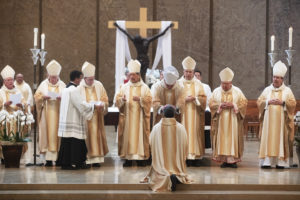The following is part of Angelus’ special reporting on the historic ordination of four new auxiliary bishops for the Archdiocese of Los Angeles Sept. 26, 2023.
On March 26, 2001, Archbishop Charles Chaput laid hands on Father José H. Gomez and recited a prayer of consecration. At that moment, Father Gomez received the fullness of the sacrament of Holy Orders. He became an auxiliary bishop for the Archdiocese of Denver.
Chaput was his chief consecrator — but not his only consecrator. He was joined, according to custom, by two “principal consecrators”: Joseph Fiorenza, who was bishop (and later archbishop) of Galveston-Houston, and Javier Echevarría, who was then prelate of Opus Dei (and also a bishop). Those co-consecrators also laid hands on José Gomez, and they also recited the prayer.
Only one bishop is necessary for a valid consecration. But the Catholic Church has, from the beginning, always expressed a strong preference for at least two more bishops to take an active part in the ceremony.
There are, as always, very good reasons for this.
The first is collegiality. No bishop is an island entire of himself. He acts in communion with other bishops, under the authority of the pope. Co-consecration, then, is an outward sign of a new bishops connection with his fellows in the episcopate. He is dependent upon them. For him, they have been a means of grace. With God, they have made him what he is.
By their consecration, he is now what they are: bishops in the one, holy, catholic, and apostolic Church. His ministry and his Church are bound up with the ministry of other bishops and other dioceses. The consecration rite itself speaks to the unity and catholicity (universality) of the churches.
As St. Paul told the Ephesians: “There is one body and one Spirit, just as you were called to the one hope that belongs to your call, one Lord, one faith, one baptism, one God and Father of us all, who is above all and through all and in all” (Ephesians 1:4-6).

There are other, very practical reasons why the Church recommends co-consecration.
Church history is as rife with conflict as any other type of history. And so much of that conflict swirls around the office of bishop. Not long after Jesus’ ascension to heaven, St. Pope Clement I recognized this fact of ecclesiastical life. He wrote: “Our apostles also knew, through our Lord Jesus Christ, that there would be strife on account of the office of the episcopate.” They knew there would be contention over the office, and so they established protocols for the selection, preparation, and ordination of candidates.
When three bishops make the consecration, it’s harder for anyone to contest the validity of the action. It’s three times harder to question the consecrator’s intention.
In the fourth century co-consecrators were especially necessary. It was a time of intense division in the Church. Heresies were spreading and metastasizing, and there were struggles for control at every level, from the parish to the papacy. Renegade bishops took it upon themselves to multiply ordinations, in order to create more bishops to be their political allies.
In the year 325 the first ecumenical council — the Council of Nicaea — tried to curb these practices by requiring co-consecration. Its fourth canon decreed: “a bishop ought to be chosen by all the bishops of his province, but if that is impossible because of some urgent necessity, or because of the length of the journey, let three bishops at least assemble and proceed to the consecration, having the written permission of the absent.”
Co-consecration forced neighboring bishops to collaborate and arrive at consensus — even if they were fiercely opposed to one another.
The last of the Western Fathers, St. Isidore of Seville, remarked: “[The custom] that a bishop should not be ordained by one bishop, but by all the comprovincial bishops, is known to have been instituted on account of heresies, and in order that the tyrannical authority of one person should not attempt anything contrary to the faith of the Church.”
The Church has a way of resolving disputes and differences, gradually over generations, and co-consecration is part of the process.
Co-consecration is a beautiful symbol — a vivid sacramental sign — of what happens invisibly during the rite of ordination. God is extending apostolic succession to a new generation. He has called another priest to the college of bishops.

